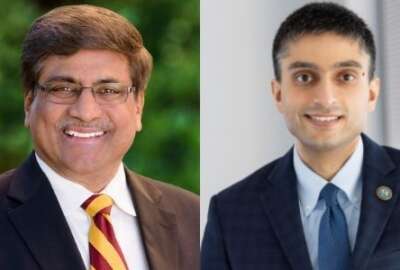How the National Science Foundation recognizes the nation’s top young scientists
Young, top-notch scientists have a shot at recognition from the National Science Foundation. Each year the NSF names an early-career scientist to its Alan T.
Best listening experience is on Chrome, Firefox or Safari. Subscribe to Federal Drive’s daily audio interviews on Apple Podcasts or PodcastOne.
Young, top-notch scientists have a shot at recognition from the National Science Foundation. Each year the NSF names an early-career scientist to its Alan T. Waterman award. This year it named three. For what the award is all about and why the foundation has it, the Federal Drive with Tom Temin spoke to program manager Gayle Pugh Lev.
Interview transcript:
Tom Temin: Let’s begin with Alan T. Waterman, a famous figure in the annals of NSF. Tell us who he was and why the contest is named after him.
Gayle Pugh Lev: Alan Tower Waterman was the first director of NSF. And he served as the director for two terms from 1951 to 1963. And he really established the core mission of NSF to support researchers across the country who are forging new paths on the frontiers of science, and enabling groundbreaking discoveries.
Tom Temin: The award then honors pretty much young scientists. That’s the aim of it here?
Gayle Pugh Lev: Yes, Dr. Waterman was widely known for advancing students and encouraging the development of young scientists as leaders in their fields. So he was a strong supporter of early career researchers.
Tom Temin: And people that think they might have a shot at this award, what do they need to do not just so much in filling out an entry form, but what should they expect to have had in their background that would make them eligible?
Gayle Pugh Lev: So that is up to the nominator. Nominations are received from people who would nominate someone for the Waterman Award. And as they see someone as an outstanding leader among their peers, who in their early career made groundbreaking discoveries, and just really standout scientist and engineers.
Tom Temin: Right. So the nominations tend to come from older professors, mentors, or perhaps employers, can they be in industry to be eligible?
Gayle Pugh Lev: Yes, they can be in industry and be eligible, yes.
Tom Temin: All right. Let’s talk a minute about this year’s winners. There were three of them just briefly tell us who they were and why they got the award.
Gayle Pugh Lev: Well, this is the first year that we’ve had three awardees. I mean, the 46 year history that we’ve had the Waterman Award, there have been 54 awardees, and it wasn’t until 2012 that we started recognizing more than one awardee. And we only did that a few times. So there have been 54 awardees since 1976. This year, we nominated three and part of that is because of the increasing scale of the nation’s science and engineering community. And also we want to recognize a broader diversity of researchers. You know, when you only recognize one person a year, you have a narrow pool.
Tom Temin: Who were this year’s awardees and tell us a little bit about them.
Gayle Pugh Lev: So this year, we have three awardees, Daniel B. Larremore, a computational epidemiologist from the University of Colorado in Boulder, Lara A. Thompson, a biomedical engineer from the University of the District of Columbia and Jessica E. Tierney a geoscientist from the University of Arizona.
Tom Temin: So you cover not just a diversity of people, but a diversity of fields it sounds like.
Gayle Pugh Lev: Right.
Tom Temin: These are mostly people that are say under 35. Is that a fair way to characterize them?
Gayle Pugh Lev: The eligibility requirements are that the people are 40 years of age or younger, or not more than 10 years beyond their Ph.D. in the year in which the nomination is submitted. So like if you were to submit a nomination for someone this year, in 2022, they would need to be born in 1982 or later, or received their Ph.D. in 2012 or later.
Tom Temin: Sure, and I guess it’s fair to say too, and correct me if I’m wrong, they should have demonstrated some original piece of work almost like a Ph.D. they’ve advanced say computational science or geology, whatever the case might be, in some manner.
Gayle Pugh Lev: Oh, absolutely. And yeah, if I can, I would like to say a little bit about their research that they’ve done. I mean, they’ve all done such exciting things, and like you pointed out, have very different expertise.
Tom Temin: Sure, tell us.
Gayle Pugh Lev: So Dr. Larremore is recognized for his work using computational epidemiology to address the questions regarding countermeasures used during the COVID-19 pandemic. So in his research, he created models that provided answers to questions about how to administer the vaccine, and what role rapid testing could play in mitigating viral transmission. His work has had enormous impacts on how we understand pandemics now and in the future.
Tom Temin: All right, and next?
Gayle Pugh Lev: Dr. Lara Thompson, the biomedical engineer, she combines medicine and engineering to develop solutions to improve the lives of individuals with balance, gait and postural impairments. She uses assistive technologies and robotics towards improving balance in elderly individuals and survivors of strokes as well as developing technologies that can increase balance, confidence and reduce the risk of falling for these groups of individuals as well.
Tom Temin: All right, sounds like someone that stands on the back of a BOSU ball.
Gayle Pugh Lev: And then Dr. Jessica Tierney, so she has done groundbreaking research in the field of climate modeling and approaches to understanding past climate conditions. So she uses modeling techniques with paleo climate data assimilation to generate maps of past climate conditions and the system dynamics that produce those conditions. And her research has redefined our understanding of global temperatures in the geologic past and helped to develop a new quantitative understanding of temperature and climate sensitivity to past levels of carbon dioxide. And her findings are important for understanding the climate of our future.
Tom Temin: All right, we’re speaking with Gayle Pugh Lev, she’s program manager for the Office of Integrative Activities at the National Science Foundation. And who judges, who decides who gets the awards each year?
Gayle Pugh Lev: NSF is very fortunate to have a distinguished group of individuals volunteer to be evaluators for the Waterman nominations. So these are individuals that are at the forefront of their fields of research. They are appointed by the director of NSF in the different fields that are represented by the NSF to evaluate these.
Tom Temin: Got it. So this year was Dr. Panchanathan, then that appointed them?
Gayle Pugh Lev: That’s correct.
Tom Temin: Do the winners get a prize other than a nice plaque? I mean, this is the government or maybe there’s some industrial partners that can give them a little green?
Gayle Pugh Lev: The size the Alan T. Waterman Medal, and the recognition that goes along with winning the Waterman Award, the awardees, since 2012, receive a million dollars to use over five years.
Tom Temin: For research.
Gayle Pugh Lev: For research, yes, to advance their research and that grant goes to the institution of the recipients choice.
Tom Temin: So nobody can buy a new Corvette if they win this award. This is to their science.
Gayle Pugh Lev: Yes, that’s correct. It’s it’s basically a prize, but it’s administered as a grant.
Tom Temin: And how many people get nominated each year?
Gayle Pugh Lev: This past year, we had 110 nominations.
Tom Temin: Wow. So it kind of makes you feel confident in the future of STEM in the future of science and technology and innovation in the United States.
Gayle Pugh Lev: Yeah, the nominations that we received are phenomenal. So it is really a difficult task to narrow it down to even three awardees.
Tom Temin: And are any of the past awardees have they gone on to famous scientific work? Have we heard of any of them?
Gayle Pugh Lev: Yes, there are many, many notable winners from past awards, and most of the Waterman Award recipients have continued to flourish in their respective fields and made significant scientific and engineering advancements that impact our health and welfare of our daily lives. Well, they’ve continued to go on to be recognized with national and international awards, including two that have received the National Medal of Science and three that have received the Nobel Prize. Eric Cornell, Richard Axel and Jennifer Doudna she won it in 2020. So the awardees they’ve you know, helped to improve our understanding of DNA, further biomedical and cancer research, decoded our sense of smell, create a new forms of matter. And they’re working on devices for energy storage and energy conversion that you know, help with clean energy. They’ve also made numerous groundbreaking discoveries in quantum computing, material science, genome editing, mathematical analysis and string theory to name a few.
Tom Temin: We’ve heard about them first, then at the NSF Waterman awards.
Gayle Pugh Lev: Right. Yes, the National Medal of Science winners include Edward Witten, and Jacqueline Barton.
Copyright © 2025 Federal News Network. All rights reserved. This website is not intended for users located within the European Economic Area.
Tom Temin is host of the Federal Drive and has been providing insight on federal technology and management issues for more than 30 years.
Follow @tteminWFED






